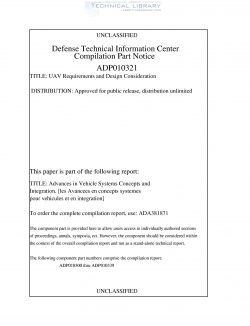DTIC-AD-P010321
- Version
- 255 Downloads
- 1.12 MB File Size
- 1 File Count
- March 5, 2017 Create Date
- March 5, 2017 Last Updated
UAV Requirements and Design Consideration

1. SUMMARY This paper deals with the UAV requirements based on the battlefield experiences. IJAV roles in tactical areas and constraints, which affect the UAV mission to be conducted, are explained and suggestions are given. Constraints; such as environmental conditions, effects on UAV missions, battlefield situations, operational restrictions and technological limits are overviewed. Based on the current applications and systems, some remarks are presented. Considering the future requirements; air vehicle performance, data link and expected payload specifications for a general UAV system are addressed. Assessments and recommendations are given for system design consideration. 2. INTRODUCTION There have been increasing demands in modem world to use UAV systems as Intelligence, Reconnaissance, Surveillance and Target Acquisition Systems. Although requirements for UAVs change based on the missions to be carried, expectations are generally similar for each type. Cost-effectiveness, reliability, maintainability, usefulness and operational availability are some of the requirements that all systems should have. Besides these, all UAV system should also lillfill certain basic requirements, as outlined below: • Performing emcient surveillance and reconnaissance missions for the armed forces Day and night operations Operating in a wide range of weather conditions Various altitude operation Beyond Line-of-Sight (BLOS) operation Real-time operation Multi-mission capability, etc. These requirements help to define the UAV system specifications in terms of the performance parameters of the following basic subsystems: Air vehicle Ground control station Payloads Data link Support equipment Performance parameters are closely interrelated and usually shape these subsystems. At the beginning of the program definition phase, requirements are always beyond the technological advances. However, an optimum cost-performance system definition can be reached by adequate trade-off studies, taking operational concepts and technological capabilities as parameters. Requirements and system specifications for each subsystem are considered in the next section of this paper. Following these assessments, general issues such as reliability, availability, maintainability, mobility, transportability, deployability, sustainability, environmental conditions, survivability, safety, interchangeability and modularity aspects of UAV systems are examined.
| File | Action |
|---|---|
| DTIC-AD-P010321 UAV Requirements and Design Consideration.pdf | Download |

Comment On This Post